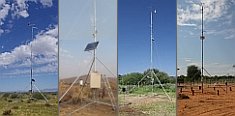|
|||||||||||||
 |



Weather data

A large number of automatic weather stations has been implemented in the frame of the BIOTA AFRICA project by the Namibian National Botanical Research Institute (NBRI) and the Group "Biodiversity, Evolution and Ecology" (BEE) of the University of Hamburg. The website offers hourly updates of data and graphs of a large number of weather parameters.

|
THE FRAME PROJECT: BIOTA AFRICA BIOdiversity Monitoring Transect Analysis in Africa Towards Sustainable Use and Conservation of Biodiversity in Africa Short summary BIOTA AFRICA is a cooperative, interdisciplinary and integrative research project with contributions from and in Benin, Burkina Faso, Germany, Ivory Coast, Kenya, Uganda, Namibia and South Africa. Initiated in 1999, and at present funded mainly by the German Federal Ministry of Education and Research (BMBF), the project has developed towards a cooperative network: Since 2003, the goals, structures and activities have been jointly defined by scientists and institutions involved in the countries named above. The project aims at a holistic scientific contribution towards sustainable use and conservation of the biodiversity of the African continent. Goals include:
The project understands its activities as a contribution to the International Diversitas program, the goals of the relevant UN conventions (UNCBD and UNCCD) and to the Johannesburg Plan of Action of the World Summit on Sustainable Development (WSSD). |
 Go to the WeatherNet
Go to the WeatherNet